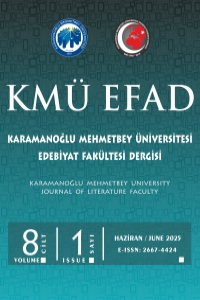Öz
During the 5th and 4th centuries BC, the Sophists claimed that the concepts of nomos and physis were opposites. They contended that “nomos” implied human traditions, conventions, beliefs, and the political institutions and legal regulations in which people lived, and therefore varied from city to city and person to person. They defined “physis,” conversely, as “nature,” the unchanging principle underlying all things. Plato did not accept nomos-physis as a dichotomy and attempted to close the nomos-physis gap the Sophists advocated. Plato based his understanding of society and its rules on the world of unchanging forms, since according to him, the world of forms is essentially the metaphysical and ontological theory of nature. He claimed that the philosopher constructs the order of society by looking at the order of divine ideas. Therefore, in the Republic, Plato bases “nomos” on justice itself, that is, the form of justice, and “nomos” in harmony with nature when it protects justice; as forms are the highest principles of nature, part of the nature of things. In other words, according to Plato, the nature of things is determined by forms, so true and natural laws can be created by reference to forms. This article explains how Plato tried to close the nomos-physis gap by basing it on the world of forms.
Kaynakça
- Bozkaya, K. (2024). İdeal Devletin Yeryüzüne İnişi: Platon’un “Devlet” ve “Yasalar” Adlı Eserlerinin Teorik-Pratik Bakımdan Karşılaştırılması. Akademik Sosyal Araştırmalar Dergisi, 12 (157), 209-225.
- Kanat, C. A. (2013). Platon ve Aristoteles’te Devlet ve Toplum Felsefesi. İstanbul, Doruk Yayıncılık.
- Micheal, G. (2002). Antıphon The Athenıan, Oratory, Law, and Justice in the Age of the Sophists. Austin, University of Texas Press.
- Morrow, G. R. (Ed. By M. Konvitz and A.E. Murphy). (1948). Plato and the Law of Nature. in Studies in Political Theory. Ithaca, N.Y.
- Ostwald, M. (Ed. Helen F. North). (1977). Plato on Law and Nature. In Interpetations of Plato. The Netherlands, Lugdini Bavatorum E. J. Brill.
- Platon. (2015). Gorgias. Diyaloglar, (T. Aktürel, Çev.). İstanbul, Remzi Kitapevi.
- Platon. (1997b). Protagoras, (N. Ş. Kösemihal, Çev.). İstanbul, MEB Yayınları.
- Platon. (2007). Devlet, (C. Saraçoğlu, V. Ataman, Çev.). İstanbul, Bordo-Siyah Yayınları.
- Platon. (2007a). Yasalar, (C. Şentuna, S. Babür, Çev.). İstanbul, Kabalcı Yayınevi.
- Raven, J.E. (1965). Plato’s Thought in the Making. Cambridge, Cambridge University Press.
- Seferoğlu, T. (2003). Yalanlar, Hikayeler ve Argümanlar: Asil Yalansız Bir Kallipolis Mümkün mü?. Felsefe Arkivi, 58, 89-110.
- Tuğcu, T. (2000). Batı Felsefesi Tarihi. İstanbul, Alesta Yayınları.
Öz
MÖ. 5. ve 4. yüzyıllarda sofistler tarafından nomos ve physis kavramlarının birbirine zıt olduğu iddia edilmiştir. Nomosun insan geleneklerini, uzlaşımlarını, inançlarını ve insanların yaşadığı siyasi kurumları ve yasal düzenlemeleri içerdiğini ve dolayısıyla şehirden şehire, kişiden kişiye değiştiği iddia edilmiştir. Physis ise “doğa”; tüm şeylerin altında yatan değişmez ilke olarak tanımlanmıştır. Platon, Sofistlerin ileri sürdüğü nomos-physis karşıtlığını kabul etmez ve onların açtığı nomos-physis yarığını kapatmaya çalışmıştır. Platon topluma dair kurallarını değişmez formlar dünyasına dayandırır, çünkü formlar dünyası esasında, doğanın metafiziksel ve ontolojik teorisidir. Filozof tanrısal idealar düzenine bakarak toplumun düzenini inşa eder. Dolayısıyla Devlet’te nomos, adaletin kendisine, yani adalet formuna dayandırılmaktadır ve nomos, adaleti koruduğunda doğayla uyum içerisindedir. Çünkü formlar, doğanın en yüksek ilkeleridir. Zira formlar aynı zamanda şeylerin doğasıdır. Yani şeylerin doğasını formlar belirler, o hâlde aslında doğru ve doğaya uygun yasalar da formlara referansla oluşturulabilir. Bu makalede Platon’un nomos-physis yarığını formlar dünyasına dayandırılarak nasıl kapatmaya çalıştığı açıklanacaktır.
Kaynakça
- Bozkaya, K. (2024). İdeal Devletin Yeryüzüne İnişi: Platon’un “Devlet” ve “Yasalar” Adlı Eserlerinin Teorik-Pratik Bakımdan Karşılaştırılması. Akademik Sosyal Araştırmalar Dergisi, 12 (157), 209-225.
- Kanat, C. A. (2013). Platon ve Aristoteles’te Devlet ve Toplum Felsefesi. İstanbul, Doruk Yayıncılık.
- Micheal, G. (2002). Antıphon The Athenıan, Oratory, Law, and Justice in the Age of the Sophists. Austin, University of Texas Press.
- Morrow, G. R. (Ed. By M. Konvitz and A.E. Murphy). (1948). Plato and the Law of Nature. in Studies in Political Theory. Ithaca, N.Y.
- Ostwald, M. (Ed. Helen F. North). (1977). Plato on Law and Nature. In Interpetations of Plato. The Netherlands, Lugdini Bavatorum E. J. Brill.
- Platon. (2015). Gorgias. Diyaloglar, (T. Aktürel, Çev.). İstanbul, Remzi Kitapevi.
- Platon. (1997b). Protagoras, (N. Ş. Kösemihal, Çev.). İstanbul, MEB Yayınları.
- Platon. (2007). Devlet, (C. Saraçoğlu, V. Ataman, Çev.). İstanbul, Bordo-Siyah Yayınları.
- Platon. (2007a). Yasalar, (C. Şentuna, S. Babür, Çev.). İstanbul, Kabalcı Yayınevi.
- Raven, J.E. (1965). Plato’s Thought in the Making. Cambridge, Cambridge University Press.
- Seferoğlu, T. (2003). Yalanlar, Hikayeler ve Argümanlar: Asil Yalansız Bir Kallipolis Mümkün mü?. Felsefe Arkivi, 58, 89-110.
- Tuğcu, T. (2000). Batı Felsefesi Tarihi. İstanbul, Alesta Yayınları.
Ayrıntılar
| Birincil Dil | Türkçe |
|---|---|
| Konular | Eskiçağ Felsefesi |
| Bölüm | Makaleler |
| Yazarlar | |
| Erken Görünüm Tarihi | 10 Haziran 2025 |
| Yayımlanma Tarihi | 30 Haziran 2025 |
| Gönderilme Tarihi | 16 Nisan 2025 |
| Kabul Tarihi | 30 Mayıs 2025 |
| Yayımlandığı Sayı | Yıl 2025 Cilt: 8 Sayı: 1 |
Kaynak Göster
Karamanoğlu Mehmetbey Üniversitesi Edebiyat Fakültesi Dergisi Creative Commons Atıf-GayriTicari-Türetilemez 4.0 Uluslararası Lisansı ile lisanslanmıştır.
Karamanoglu Mehmetbey University Journal of the Faculty of Letters is lisensed under a Creative Commons Attribution-NonCommercial-No Derivative 4.0 International License.



